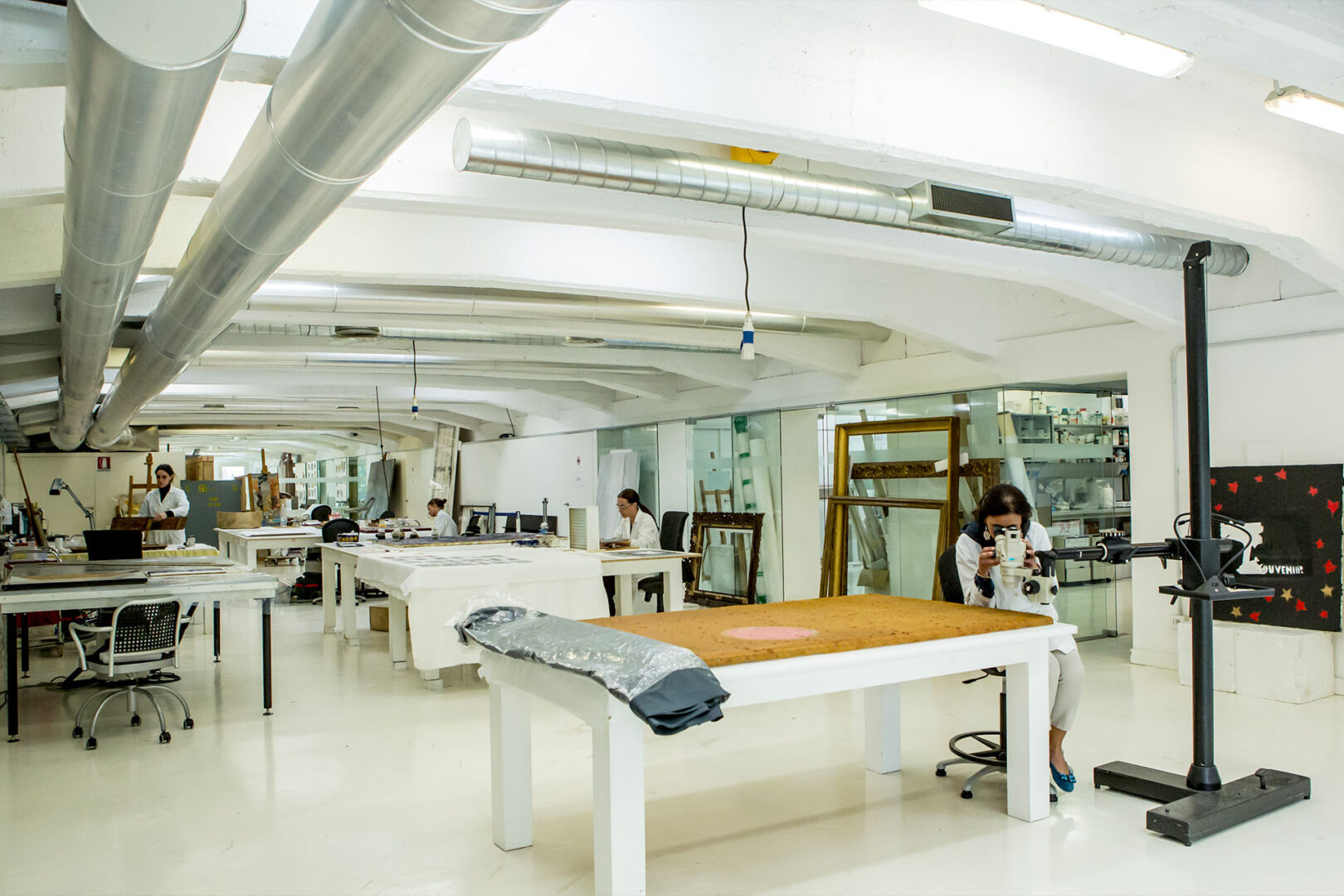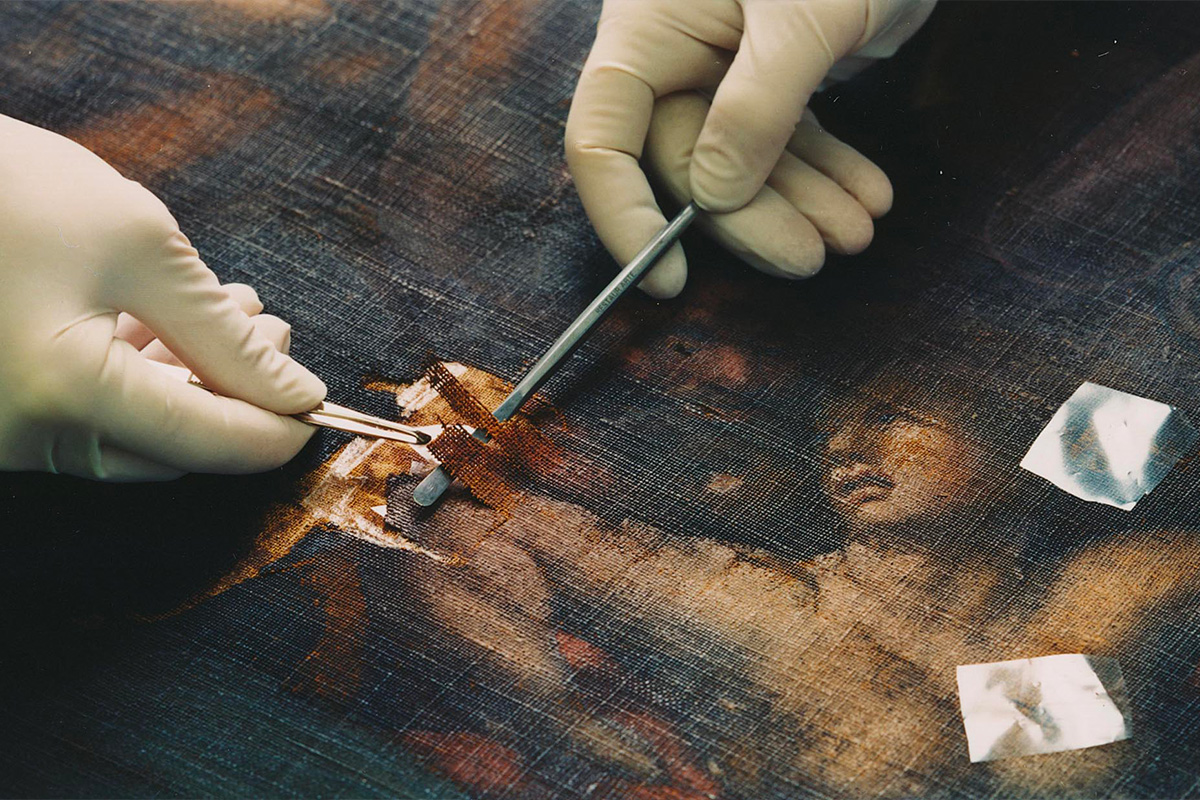The director of the Conservation and restoration department of Open Care expounds the technical, methodological and ethical issues restorers have to deal with when restoring a contemporary artwork
Lampoon introduces Isabella Villafranca Soissons
Born into a family of collectors – her father was passionate about ancient art, while her maternal grandparents collected contemporary art (mainly the Turin school, such as Casorati, etc.) – Isabella Villafranca Soissons claims to have been a very dull child. «As a reward, I used to ask my parents to take me to antique dealers’ shops on Saturday afternoons. As a result, I have always been interested in all kinds of art. From textile fragments to Japanese vases and Chinese jade. And I have always studied a lot».
Villafranca Soissons always knew she wanted to work within the conservation of artistic heritage, but after finishing high school, she was unsure which path to choose. «There were no specific courses in conservation in my day. So I decided to graduate from the Politecnico di Torino in architectural restoration, where I gained notions of chemistry, the science of materials, fluids, physics, etc., beneficial for the profession of a conservator, more than for that of the restorer». However, once she graduated, she realized she lacked direct contact with the subject and decided to also graduate in restoration in Florence.
She approached the conservation of contemporary art during an internship at Tate Gallery, where she worked in the materials research department and had the opportunity to focus her studies mainly on contemporary art. «At first, I was not happy that I was assigned to that department. At the time in Italy, there was still no talk of the restoration of contemporary art. When I returned home in the 2000s, there were very few experts on the subject. Nowadays, it is a trend because the art market is biased towards contemporary art. The contemporary art world is varied, ranging from works worth just € 5000 to others worth several million», Villafranca Soissons claims.
Restoring contemporary artworks: challenges and complexities
The procedures are now well established in the ancient art sector, where the protocols have been developed over years and years of experience. On the contrary, contemporary art represents a continuous source of surprise and discovery for restorers. «The most important thing is to understand the artist’s message and the materials you are going to work with. You cannot distort a work that could be designed to self-destruct over time. There could be opposing interests between the collector and the artist».
If the artist is still alive, Villafranca Soissons advises involving them in the preliminary stage. According to the law on copyright, it is the right of the artist to disavow a work that was not properly preserved and restored. Therefore, it is essential to discuss the restoration process with their archive if the artist is deceased. «As for the materials employed by contemporary artists, they are not all the same as many might think. An alchemical color, for example, has different behaviors than acrylics or vinyls. People always talk about acrylics, but we have to characterize and understand the materials through specific studies», Villafranca Soissons explains.
Contemporary art restorers encounter many difficulties during their interventions, both on a technical and scientific level and a theoretical and methodological one. «How far is it lawful to intervene? When and how to ask for the intervention of the artist? It would be better to avoid asking for direct intervention on the work because artists rarely manage to compress their need for evolution». Villafranca Soissons argues that if an artist is allowed to participate in the restoration process of a work conceived many years earlier and no longer shares its message. They might try to modify it.
For this reason, after the compositional moment has ended, the artist should no longer physically deal with the artwork. The risk primarily concerns using materials that struggle to coexist due to their intrinsic properties. «Sometimes, I put my hands on works which the author has repainted. Over time the two films denounce their diversity: they detach and deteriorate in different ways. Unfortunately for many people, it is easier to repaint a monochrome work than to clean it up!», Villafranca Soissons explains.
The restoration of contemporary artworks also involves a lot of ethical issues. Which are the degradations put in place by the artist? And which are the “natural” ones which need to be stopped? The restoration activity is based on the principles theorized by Cesare Brandi in the 1930s. However, they cannot be uniquely applied to contemporary art. «One of the key principles is that the intervention must be recognizable. In the case of contemporary art, the value of work could drop due to a recognizable intervention. But on the other hand, the contemporary art market requires the works to be perfect and does not denounce a restoration intervention. Here lie the difficulties: the interventions must be ethically correct, but invisible».
The employment of unusual materials in contemporary artworks
According to Villafranca Soissons, contemporary artists are not as interested in the material as they are in the message they can communicate. For this reason, they employ any materials or objects in the production of their works (ready-mades are an example of this approach). «It is essential to preserve contemporary works correctly – it is better to conserve contemporary art than to restore it», Villafranca Soissons explains. Therefore, it is necessary to pay attention to the maintenance conditions: temperature, relative humidity, dust – those of our cities have very harmful metal ions which favor the proliferation of molds and bacteria. «Many people do not think contemporary art should be maintained and preserved. In 1995 I wrote a book on the subject after speaking at the Biennale with a collector I considered one of the greatest, who asked me, amazed, ‘Does contemporary art need to be restored?’». Small interventions allow collectors to keep a work in excellent condition. On the contrary, major restoration works are more complex, risky, expensive, and can affect the value of the work.
The world of plastics is remarkably varied. Many plastics have different behaviors: some become sticky and melt over time, and others harden and crack. During her career, Villafranca Soissons confronted herself with young artists who had started working with plastics and whose works had undergone significant degradation. «During my lessons, I always do two examples of works that I would never want to deal with as a restorer: the first is “Self portrait” by Mark Quinn, made with 10 pints of his frozen blood and kept in a frozen silicone cube. If, after a black out, I was called to intervene on a pool of blood, there would be nothing to do to restore it. The second one is a land artwork by Oppenheim on the Santomato farm in Celle, conceived as a launch pad around a centuries-old oak. A few years ago, Versilia was hit by a tornado, and the oak was cut down. How do we intervene in such a case? This is where ethical issues come into play».
The current and future evolutions of restoration
Villafranca Soissons claims that the restoration market is irrelevant from an economic perspective. All the equipment used by restores is borrowed from other fields: that of medicine and healthcare for the instruments and of chemistry for the chemical products. «In recent years, the analysis phase before the restoration has changed a lot».
The photographic documentation is now digital, and the artworks’ condition reports can be shared more easily with the other people involved in the restoration. The x-rays are also digital and can be done in the laboratory without transporting the work elsewhere.
Thanks to digitization, the radiographs do not have to be printed, which implies a reduction in the use of acids and savings in the disposal of particular waste. «Technology also makes it possible to fight counterfeit more easily. Blockchain, for instance, makes it possible to trace the history of the work and the transfer of ownership. I have been working recently on a project whose goal is to demonstrate the work’s authenticity through documentation physically. In my career, I had to deal with two cases of counterfeiting. This happens when the works participate in exhibitions of non-first level circuits», Villafranca Soissons explains.
According to Villafranca Soissons, new methodologies will be developed in the following years, which will allow less heavy interventions. More attention will be paid to ordinary and extraordinary maintenance with a significant advantage for work, which will not be subjected to unnecessary stress. She also expects the future of restoration to be greener, as many restorers already employ green methodologies and solvents in their work.
Isabella Villafranca Soissons
Born in Turin in 1961, Isabella Villafranca Soissons graduated as a Restorer of paintings at the Institute for Art and Restoration in Florence and graduated in Architecture at the Polytechnic of Turin. Since 1994 she has been working in Open Care, first as technical director of the Paintings and multi-material works laboratory and since 2000 as director and scientific manager of the Conservation and Restoration Department.




















